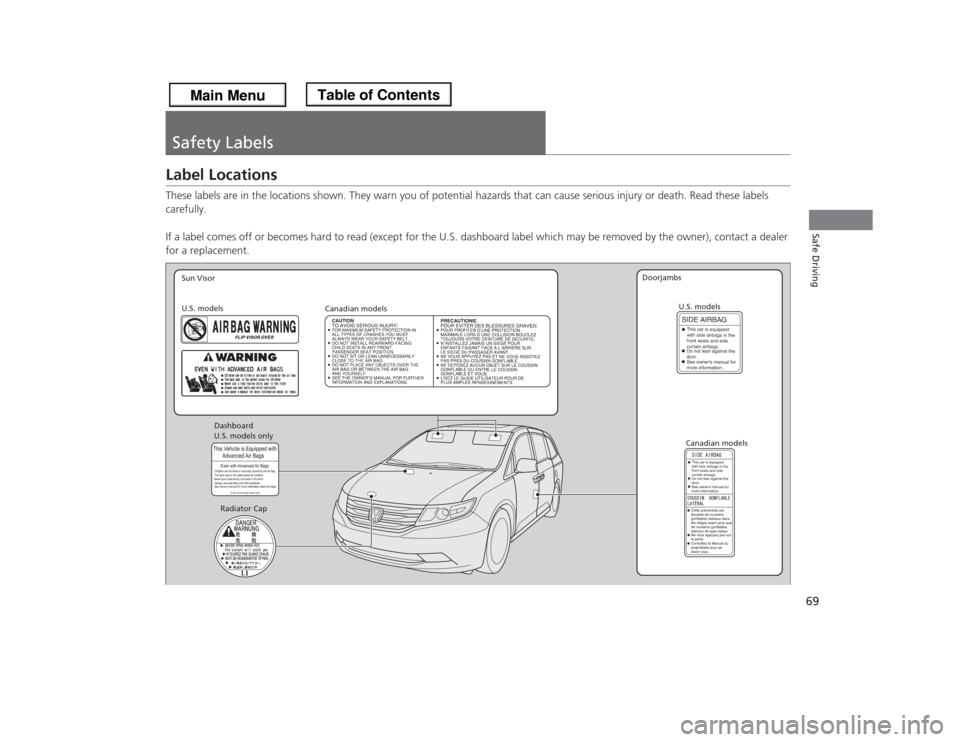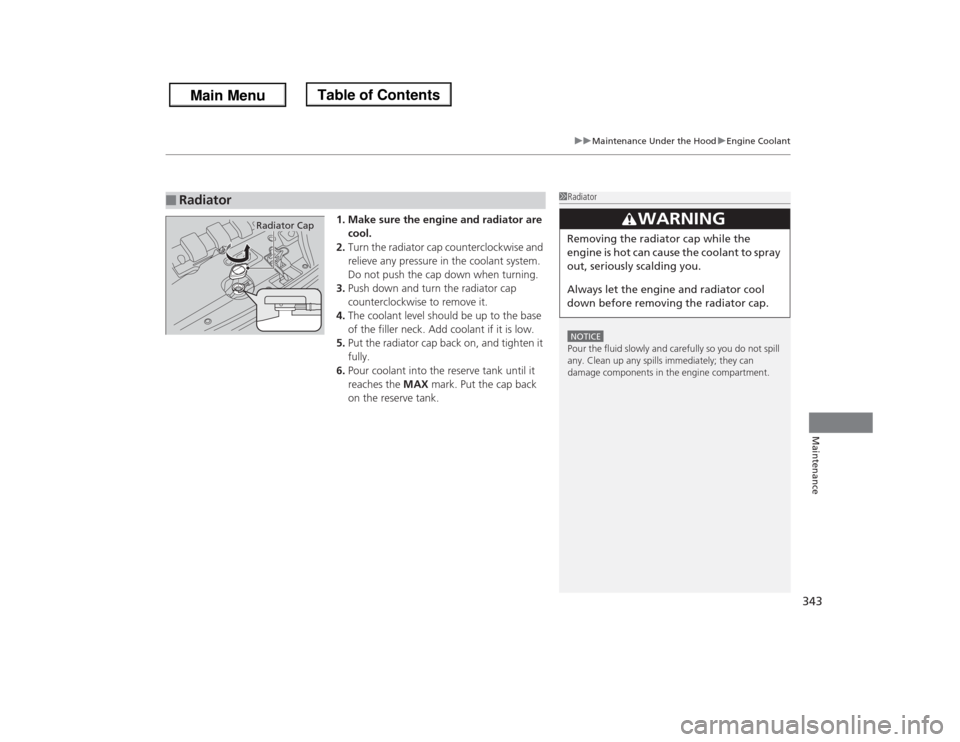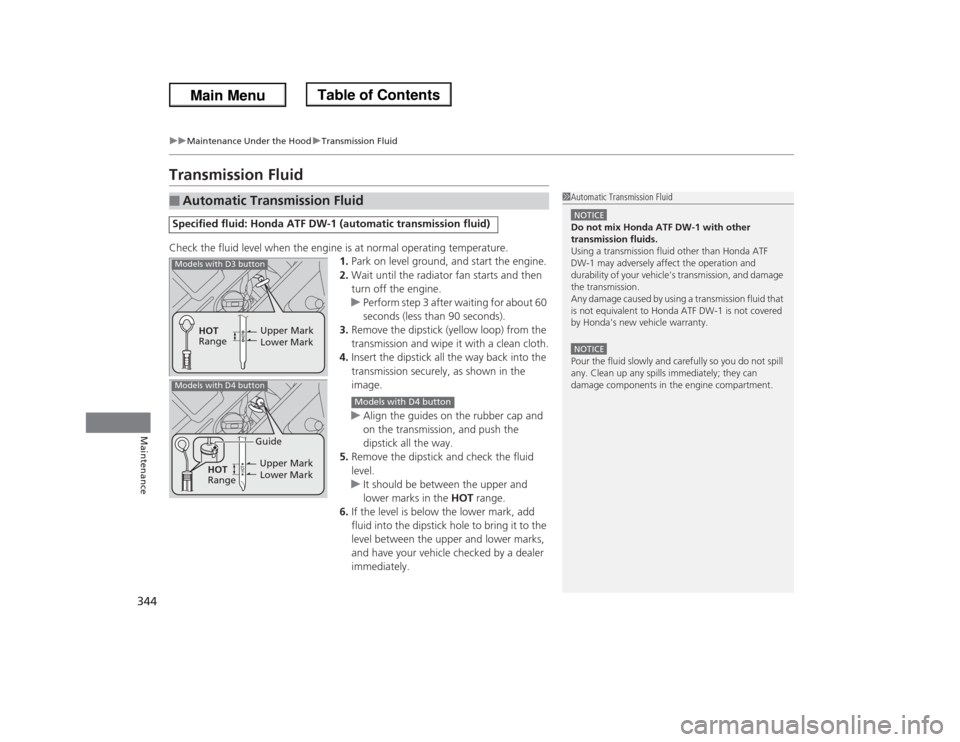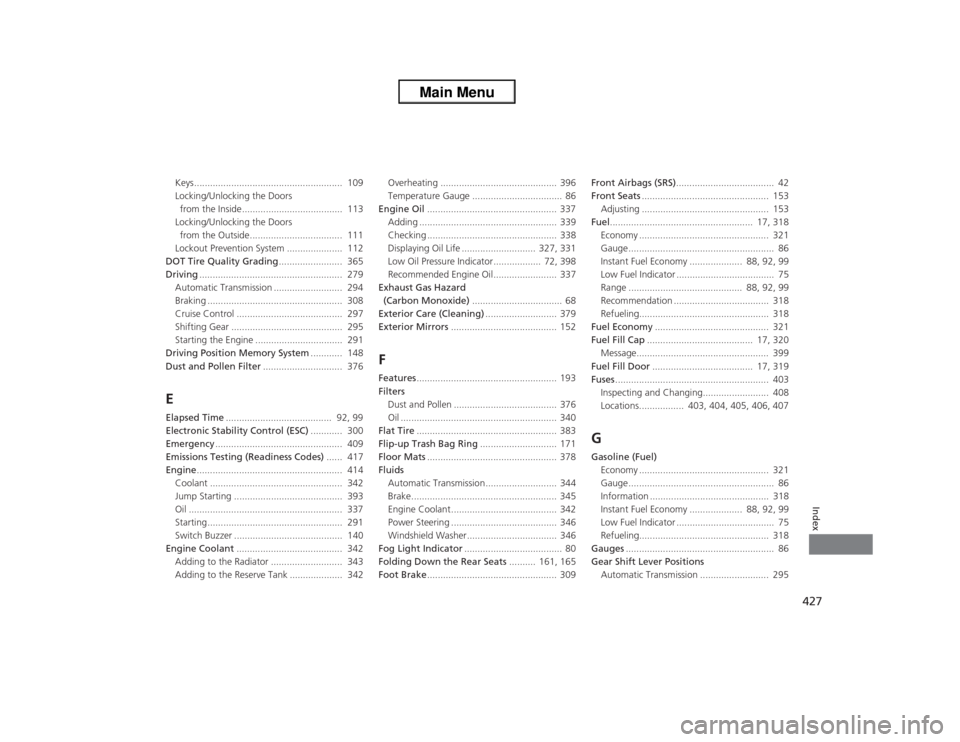2013 HONDA ODYSSEY radiator cap
[x] Cancel search: radiator capPage 70 of 433

69Safe Driving
Safety LabelsLabel LocationsThese labels are in the locations shown. They warn you of potential hazards that can cause serious injury or death. Read these labels
carefully.
If a label comes off or becomes hard to read (except for the U.S. dashboard label which may be removed by the owner), contact a dealer
for a replacement.
Sun Visor
U.S. models
Canadian models
Radiator CapU.S. models
U.S. models onlyDashboard
Canadian models Doorjambs
Page 336 of 433

335Maintenance
Maintenance Under the HoodMaintenance Items Under the Hood
Engine Oil Dipstick
(Orange Loop) Washer Fluid
(Blue Cap)
Engine Coolant
Reservoir Tank
Radiator CapBrake Fluid
(Black Cap)
Engine Oil Fill Cap Automatic
Transmission Fluid
Dipstick
(Yellow Loop) BatteryPower Steering Fluid
(Red Cap)
Page 344 of 433

343
uuMaintenance Under the HooduEngine Coolant
Maintenance
1. Make sure the engine and radiator are
cool.
2.Turn the radiator cap counterclockwise and
relieve any pressure in the coolant system.
Do not push the cap down when turning.
3.Push down and turn the radiator cap
counterclockwise to remove it.
4.The coolant level should be up to the base
of the filler neck. Add coolant if it is low.
5.Put the radiator cap back on, and tighten it
fully.
6.Pour coolant into the reserve tank until it
reaches the MAX mark. Put the cap back
on the reserve tank.
■
Radiator
1RadiatorNOTICEPour the fluid slowly and carefully so you do not spill
any. Clean up any spills immediately; they can
damage components in the engine compartment.
3
WARNING
Removing the radiator cap while the
engine is hot can cause the coolant to spray
out, seriously scalding you.
Always let the engine and radiator cool
down before removing the radiator cap.
Radiator Cap
Page 345 of 433

344
uuMaintenance Under the HooduTransmission Fluid
Maintenance
Transmission FluidCheck the fluid level when the engine is at normal operating temperature.
1.Park on level ground, and start the engine.
2.Wait until the radiator fan starts and then
turn off the engine.
uPerform step 3 after waiting for about 60
seconds (less than 90 seconds).
3.Remove the dipstick (yellow loop) from the
transmission and wipe it with a clean cloth.
4.Insert the dipstick all the way back into the
transmission securely, as shown in the
image.
uAlign the guides on the rubber cap and
on the transmission, and push the
dipstick all the way.
5.Remove the dipstick and check the fluid
level.
uIt should be between the upper and
lower marks in the HOT range.
6.If the level is below the lower mark, add
fluid into the dipstick hole to bring it to the
level between the upper and lower marks,
and have your vehicle checked by a dealer
immediately.■
Automatic Transmission FluidSpecified fluid: Honda ATF DW-1 (automatic transmission fluid)
1Automatic Transmission FluidNOTICEDo not mix Honda ATF DW-1 with other
transmission fluids.
Using a transmission fluid other than Honda ATF
DW-1 may adversely affect the operation and
durability of your vehicle's transmission, and damage
the transmission.
Any damage caused by using a transmission fluid that
is not equivalent to Honda ATF DW-1 is not covered
by Honda's new vehicle warranty.NOTICEPour the fluid slowly and carefully so you do not spill
any. Clean up any spills immediately; they can
damage components in the engine compartment.
Upper Mark
Lower Mark HOT
RangeUpper Mark
Lower Mark HOT
RangeGuide
Models with D3 buttonModels with D4 button
Models with D4 button
Page 398 of 433

397
uuOverheatinguHow to Handle Overheating
Handling the Unexpected
■Next thing to do
1.Check that the cooling fan is operating and
stop the engine once the temperature
gauge needle comes down.
uIf the cooling fan is not operating,
immediately stop the engine.
2.Once the engine has cooled down, inspect
the coolant level and check the cooling
system components for leaks.
uIf the coolant level in the reserve tank is
low, add coolant until it reaches the
MAX mark.
uIf there is no coolant in the reserve tank,
check that the radiator is cool. Cover the
radiator cap with a heavy cloth and open
the cap. If necessary, add coolant up to
the base of the filler neck, and put the
cap back on.■Last thing to do
Once the engine has cooled sufficiently, restart it and check the temperature gauge.
If the temperature gauge needle has gone down, resume driving. If it has not gone
down, contact a dealer for repairs.
1How to Handle Overheating
If the coolant is leaking, contact a dealer for repairs.
Use water as an emergency/temporary measure only.
Have a dealer flush the system with proper antifreeze
as soon as possible.
3
WARNING
Removing the radiator cap while the
engine is hot can cause the coolant to spray
out, seriously scalding you.
Always let the engine and radiator cool
down before removing the radiator cap.
MAX
Reserve
Tank
MIN
Page 428 of 433

427Index
Keys........................................................ 109
Locking/Unlocking the Doors
from the Inside...................................... 113
Locking/Unlocking the Doors
from the Outside................................... 111
Lockout Prevention System ..................... 112
DOT Tire Quality Grading........................ 365
Driving...................................................... 279
Automatic Transmission .......................... 294
Braking ................................................... 308
Cruise Control ........................................ 297
Shifting Gear .......................................... 295
Starting the Engine ................................. 291
Driving Position Memory System............ 148
Dust and Pollen Filter.............................. 376EElapsed Time........................................ 92, 99
Electronic Stability Control (ESC)............ 300
Emergency................................................ 409
Emissions Testing (Readiness Codes)...... 417
Engine....................................................... 414
Coolant .................................................. 342
Jump Starting ......................................... 393
Oil .......................................................... 337
Starting................................................... 291
Switch Buzzer ......................................... 140
Engine Coolant........................................ 342
Adding to the Radiator ........................... 343
Adding to the Reserve Tank .................... 342Overheating ............................................ 396
Temperature Gauge .................................. 86
Engine Oil................................................. 337
Adding .................................................... 339
Checking ................................................. 338
Displaying Oil Life ............................ 327, 331
Low Oil Pressure Indicator.................. 72, 398
Recommended Engine Oil........................ 337
Exhaust Gas Hazard
(Carbon Monoxide).................................. 68
Exterior Care (Cleaning)........................... 379
Exterior Mirrors........................................ 152
FFeatures..................................................... 193
Filters
Dust and Pollen ....................................... 376
Oil ........................................................... 340
Flat Tire..................................................... 383
Flip-up Trash Bag Ring............................. 171
Floor Mats................................................. 378
Fluids
Automatic Transmission........................... 344
Brake....................................................... 345
Engine Coolant........................................ 342
Power Steering ........................................ 346
Windshield Washer.................................. 346
Fog Light Indicator..................................... 80
Folding Down the Rear Seats.......... 161, 165
Foot Brake................................................. 309Front Airbags (SRS)..................................... 42
Front Seats................................................ 153
Adjusting ................................................ 153
Fuel...................................................... 17, 318
Economy ................................................. 321
Gauge ....................................................... 86
Instant Fuel Economy .................... 88, 92, 99
Low Fuel Indicator ..................................... 75
Range ........................................... 88, 92, 99
Recommendation .................................... 318
Refueling................................................. 318
Fuel Economy........................................... 321
Fuel Fill Cap........................................ 17, 320
Message.................................................. 399
Fuel Fill Door...................................... 17, 319
Fuses.......................................................... 403
Inspecting and Changing......................... 408
Locations................. 403, 404, 405, 406, 407
GGasoline (Fuel)
Economy ................................................. 321
Gauge ....................................................... 86
Information ............................................. 318
Instant Fuel Economy .................... 88, 92, 99
Low Fuel Indicator ..................................... 75
Refueling................................................. 318
Gauges........................................................ 86
Gear Shift Lever Positions
Automatic Transmission .......................... 295